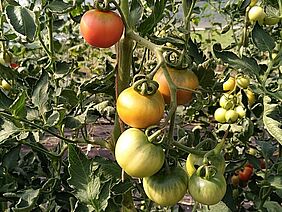The availability of organic seed has come into focus, as derogations to use conventional, untreated seeds for organic cultivation will be only possible in the EU until 2036. In order to optimise organic seed production in tomatoes and develop strategies that serve both small and large seed producers, we investigated the influence of harvest frequencies, extraction timepoints and storage of tomatoes on the yield and quality of organic tomato seeds.
Special processing steps
Compared to other vegetables, tomato seed production differs in some special processing steps. For example, the seeds are fermented in the pulp for three days before they can be separated from it through repeated rinsing.
Seed extraction can be carried out continuously in parallel to harvesting. However, this necessitates a large number of extractions and is therefore very labour-intensive. The fruits can be also left longer on the plant and extracted all at once. This come with a higher risk of loss, as the probability of infections increases with a longer hanging time. Cold storage would allow seed production to be integrated into a regular harvest, where harvest at the optimal time would reduce the proportion of waste, and pooled stored fruits reduce the number of seed extractions.
Higher seed yield in regularly harvested tomatoes
In order to determine the effect of fruit ripeness and harvest time on seed quantity and quality, the seed yield of frequently harvested tomatoes was compared with that of tomatoes with more spaced harvests. Moreover, we tested whether cold storage of harvested fruits had an effect on the seeds. For the trial, a total of eight tomato genotypes were tested and three seed extractions were carried out, each three weeks apart.
The different harvesting methods had no influence on the thousand kernel weight (TKW) and the germination rate. The total seed yield was higher in the regularly harvested tomatoes, as they not only produced more fruit, but also had significantly less waste. The cold storage of fruits for up to three weeks had no effect on the germination rates.
The TKW was the highest at the beginning of the season and decreased during the season. The first extraction yielded fewer seeds than the last. The TKW had no effect on the germination rate. Most seeds were produced mid-season, in correlation with the highest fruit yield.
Harvest for seed production: continuous or every three weeks
In summary, harvesting for seed production can be either continuous with the tomatoes stored for a pooled extraction or can be done every three weeks and extracted after removing infected fruits. This study can help small as well as large seed producers in their organic seed multiplication strategy.
This study was carried out as part of the Horizon 2020 project BRESOV, which is funded by the EU under grant agreement no. 774244.
This article was published in the open access publication Swiss Agricultural Research in July 2023.
Further information
Contact
- Patricia Schwitter
- Joëlle Herforth-Rahmé
Links
- agrarforschungschweiz.ch: Article in Swiss Agricultural Research
- fibl.org: Project "Breeding for Resilient, Efficient and Sustainable Organic Vegetable production (BRESOV)"




